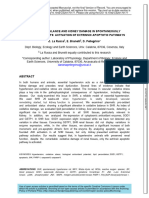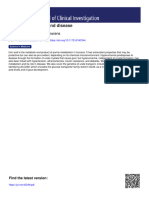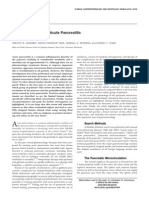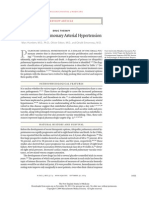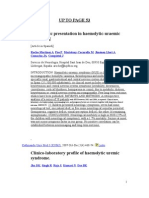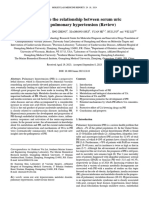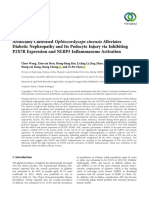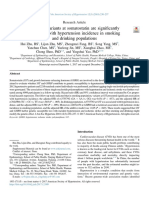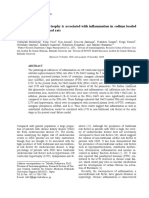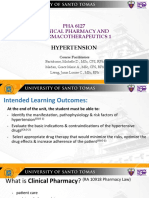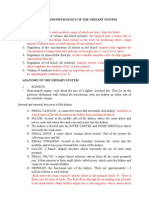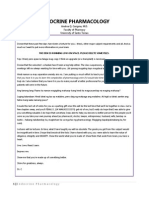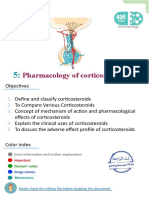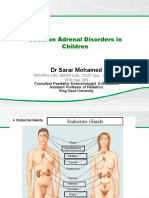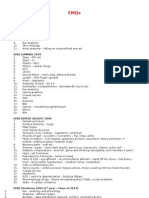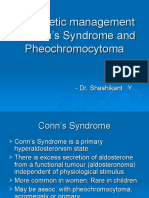Review Article: Animal Models of Hypertension: An Overview
Review Article: Animal Models of Hypertension: An Overview
Uploaded by
rodrigodaliascienceCopyright:
Available Formats
Review Article: Animal Models of Hypertension: An Overview
Review Article: Animal Models of Hypertension: An Overview
Uploaded by
rodrigodaliascienceOriginal Title
Copyright
Available Formats
Share this document
Did you find this document useful?
Is this content inappropriate?
Copyright:
Available Formats
Review Article: Animal Models of Hypertension: An Overview
Review Article: Animal Models of Hypertension: An Overview
Uploaded by
rodrigodaliascienceCopyright:
Available Formats
REVIEW ARTICLE
Animal models of hypertension: An overview
LILACH O. LERMAN, ALEJANDRO R. CHADE, VINCENZO SICA, and CLAUDIO NAPOLI
ROCHESTER, MINNESOTA; BOSTON, MASSACHUSETTS; and NAPLES, ITALY
Hypertension is a multifactorial disease involving complex interactions between genetic and environmental factors. Development of experimental models of hypertension
allowed dissection and isolation of various factors associated with regulation of blood
pressure, inheritance of hypertensive traits, and cellular responses to injury. The phenotype-driven approach is taking advantage of selective breeding of animals (primarily rats) that exhibit a desired phenotype, like the useful SHR. Genotype-driven models
include transgenic techniques, in which mice are the most successful for selective
deletion or overexpression of target genes. Notably, a combination of comparative
genomics strategies and phenotypic correlates enhances the utility of hypertension
models and their clinical relevance. Indeed, experimental models enabled development of targeted interventions aimed at decreasing not only blood pressure but also
target organ injury. Continued utilization of experimental models simulating human
hypertension, particularly those that combine other clinically relevant comorbidities
like obesity or hypercholesterolemia, may afford development of effective strategies to
address this common disease. Nevertheless, a cautious approach is mandatory when
experimental findings in these models are extrapolated to human hypertension. (J Lab
Clin Med 2005;146:160 173)
Abbreviations: 2K1C 2-kidneys, 1-clip; ACE angiotensin-converting enzyme; AngII
angiotensin II; ANP atrial natriuretic peptide; AR adrenergic receptors; AT1 angiotensin
II type 1 receptor; DOCA deoxycorticosterone-acetate; eNOS endothelial nitric oxide
synthase; ET endothelin; NO nitric oxide; PRA plasma renin activity; RAS reninangiotensin system; SHR spontaneously hypertensive rat
ypertension is a multifactorial, polygenic disease that involves complex interactions between genetically determined homeostatic control mechanisms and environmental factors,1 and its
exploration thus requires availability of experimentally
manipulable animal models. The ideal animal model
for hypertension research should have human-like car-
diovascular anatomy, hemodynamics, and physiology
and develop human disease characteristics and complications in a timely or even accelerated fashion.2 Inevitably, no species can consistently answer all of these
needs, and experimental design and other constraints
often dictate the choice of animal models for specific
research applications.
From the Division of Nephrology and Hypertension, Mayo Clinic
College of Medicine, Rochester, Minnesota; the Research Center of
Excellence in Cardiovascular Diseases and Departments of General
Pathology and Medicine, University of Naples, Naples, Italy; and the
Evans Department of Medicine and Whitaker Cardiovascular Institute, Boston University, Boston, Massachusetts.
Supported in part by NIH Grants HL-63282 and 77131, the American
Heart Association, and unrestricted research funds from Regione
Campania 2004 2005, Naples, Italy.
Submitted for publication April 8, 2005; accepted for publication
May 20, 2005.
Reprint requests: Lilach O. Lerman, Division of Nephrology and
Hypertension, Mayo Clinic College of Medicine, 200 First Street
SW, Rochester, MN 55905; e-mail: lerman.lilach@mayo.edu.
0022-2143/$ see front matter
2005 Mosby, Inc. All rights reserved.
doi:10.1016/j.lab.2005.05.005
160
J Lab Clin Med
Volume 146, Number 3
Fig 1. Schematic of the general categories of animal models of
hypertension, divided into genetic and nongenetic models. The genetic models include those that are phenotype-driven (eg, SHR) or
genotype-driven (eg, null mice). The nongenetic models include
those obtained by nongenetic interventions (eg, 2K,1C).
Several techniques for specifically altering the genome have been developed that allow single genes to be
altered. Expression of human genes and proteins in
transgenic animals beginning in fetal life allows characterization of species- and substance-specific lifelong
effects of drugs. Almost all of these studies have been
restricted to investigations of the mouse, of which
many well-characterized genetic strains are available,
much is known about its embryogenesis, and pluripotent embryonic stem cells have been isolated. The application of novel comparative genomics strategy combined with phenotypic correlates in rats and mice
support the importance of these models to human disease and enables predicting several chromosomal regions in the human genome that potentially harbor
hypertension genes.3 Thus, the purpose of this review is
to summarize the main nongenetic and genetic models
of hypertension (Fig 1) that allow new approaches to
study this disease and may facilitate development of
novel therapeutic strategies.
NONGENETIC MODELS
Secondary causes are responsible for some hypertension in humans. The underlying origin of secondary
hypertension is most often renovascular and less frequently endocrine and/or metabolic disorders (Fig 1).
Several experimental nongenetic approaches have resulted in development of extremely useful models that
allow studying the effects of induced hypertension on
end-organ damage in different species, including large
animals possibly comparable with humans.
Surgically induced hypertension. The pioneering
work of Goldblatt et al4 in 1934 introduced the first
animal model of hypertension in dogs evoked by unilateral constriction of the renal artery (2K1C model)
Lerman et al
161
and was followed by similar demonstrations in rats5
and rabbits6 in the same decade. Indeed, partial occlusion of the renal artery has subsequently been shown to
lead to development of hypertension in rats, rabbits,
dogs,7 pigs,8 monkeys,9 and mice.10. In rats11 or rabbits,12 2K1C leads to a gradual and chronic increase in
blood pressure, which plateaus after 2 weeks but may
subsequently decrease in 10 20% of animals. In general, rats develop hypertension more easily than rabbits,
but its pattern may be influenced by the clip type, diet,
and animal age. Renovascular hypertension can also be
achieved by placing a clip on the aorta (coarctation)
between the 2 renal arteries.13
End-organ damage in the 2K1C model depends on
the size and time of the clipping and usually includes
endothelial dysfunction, cardiac hypertrophy (a 20
50% increase in cardiac size), and hypertrophy of the
contralateral kidney exposed to hypertension.14,15 As in
most models of hypertension, many of these effects
derive from the increase in systemic pressure, change in
blood flow patterns (nonlaminar fluid mechanics), and
shear stress. Stretch- or diet-induced activation of oxidative enzymes such as NAD(P)H oxidase, altered nitric oxide availability, and consequently oxidative
stress and inflammation, may all contribute to endothelial dysfunction and vascular remodeling, as does activation of systemic or tissue AngII in angiotensin-dependent models.
In dogs, achieving a sustained increase in blood
pressure is more difficult because of their pronounced
renal autoregulatory capacity,16 but it can still be obtained by placing sutures17 or an inflatable occluder16
on the renal artery. Increase in blood pressure in dogs is
rapid and can be maintained for weeks,18 although
extensive collateral development within 23 months
can eventually reduce blood pressure.19 Conversely, in
2K1C cynomolgus monkeys (Macaca fascicularis), the
increase in mean arterial pressure is maximal by 4 6
weeks and sustained for over 24 weeks.9 The consequences of renal artery stenosis can also be exacerbated
by contralateral nephrectomy (1K1C model), as observed in rats,20 rabbits,21 and dogs.22 Although its
pattern may depend on dietary sodium20 or the timing
of nephrectomy, this model usually provides reliable
development of hypertension.
The 2K1C model shows some sensitivity to diet,
because changes in potassium intake can affect development of hypertension. Sodium balance depends on
the degree of hypertension and pressure natriuresis of
the contralateral kidney.23 Sodium restriction attenuates development of hypertension in young rats,24
whereas a high sodium diet increases blood pressure in
moderately hypertensive rabbits25 but not in rats.26
Contrarily, in rabbits with severe hypertension and con-
162
Lerman et al
sequent extracellular volume depletion, a high salt diet
decreases PRA and blood pressure.27
Hypertension in 2K1C may be influenced by renin
release from the stenotic kidney. Systemic PRA increases faster in rabbits28 but lasts longer in rats,29
whereas in dogs19and pigs,30 the increase may be more
rapid, but PRA returns to normal values if the hypertension is moderate. Systemic levels of AngII and aldosterone follow a similar pattern.7 There might be
several reasons for the subsequent decline in systemic
PRA.8,30 The immediate increase in blood pressure in
renal artery stenosis results from release of renin from
the stenotic kidney, and consequently AngII.
In 2K1C, the interplay between PRA and extracellular volume is complex, because the contralateral kidney
suppresses renin release3133 and increases sodium excretion, which tends to drive the blood pressure down.
This process decreases stenotic renal perfusion pressure
and resumes renin release, which in turn elevates blood
pressure, and so forth.34 36 If the increase in systemic
pressure restores the perfusion pressure of the stenotic
kidney, many humoral changes return to baseline.37,38
In high-grade renal artery stenosis, this cycle of events
may induce volume depletion and renal failure. In
contrast, in moderate and untreated experimental renal
artery stenosis, renovascular hypertension can be sustained with relatively low systemic levels of AngII, as
observed in several surgically induced hypertension
models.8,27,37,39 42 In chronic 1K1C in rats,43 rabbits,44
and dogs16, blood pressure seems to be less dependent
on the RAS45 and more on extracellular volume status,
and PRA is lower than in 2K1C.
We have recently developed a pig model of unilateral
renal artery stenosis, which was achieved by intravascular implantation of a local-irritant coil in the renal
artery that leads to a gradual proliferative neointimal
response and progressive luminal narrowing, and we
developed many pathophysiological characteristics of
human renovascular hypertension8,30 (Fig 2). The domestic pig is a good large animal model of hypertension
and end-organ injury46 because the anatomy and physiology of its renal47 and cardiovascular48 systems are
comparable with humans. We have shown that PRA
increased only transiently in this model if the stenosis is
moderate, whereas oxidative stress remains elevated
and may contribute to sustenance of hypertension.8,30
In contrast to the somewhat predictable patterns observed in different experimental models, humans with
renal artery stenosis show considerable variability in
PRA, because of a wide range in severity of stenosis,
coexistent morbidities, age, and sodium intake. PRA
may also rise because of posture or sodium restriction
during testing,49 total occlusion,50 or antihypertensive
treatment that reduces renal perfusion.51,52 Few data
J Lab Clin Med
September 2005
Fig 2. Renal angiography shows unilateral renal artery stenosis in a
pig model, including poststenotic arterial dilation. Its radiological
appearance resembles observations of renal artery stenosis in humans.
track PRA over time in patients with renal artery stenosis, but it seems to also show an early increase and
later normalize.53 Indeed, normal PRA can be found in
about 2537% of patients.50,53 PRA variability partly
explains the failure of measuring any single pathway to
predict blood pressure response to intervention in
humans.54
Less common surgical forms of renal hypertension
can be achieved by complete occlusion of both renal
arteries, which in dogs or rabbits leads to a fast and
severe increase in blood pressure, or by renal microembolization.55 In 1939, Page56 developed a model of
hypertension obtained by wrapping the kidney in cellophane or silk, which lead to perinephritis and renal
parenchymal compression,57 as applied in dogs, cats,
rabbits, and cynomolgus monkeys.58 This model seems
to be dependent on increased activity of the RAS and
ET-1.59,60 In humans, hypertension has been infrequently attributed to a process comparable with Page
kidney,61 63 and renal compression has been also suggested as a potential mechanism for obesity-induced
hypertension.64
Total or subtotal nephrectomy is also associated with
development of hypertension,65 the characteristics of
which are dependent on contributing factors such as
survival time, dietary protein, sodium and water intake,
and the presence of the adrenal gland. This procedure is
J Lab Clin Med
Volume 146, Number 3
often accompanied by diffuse vascular calcifications,
which are particularly prominent in rats.7 Generation of
renal parenchymal disease or inflammation by injection
of bacteria,66 foreign proteins, or antibodies67 have also
induced hypertension in rats, rabbits, and dogs. More
recently, administration of phenol in the lower pole of
1 kidney induced neurogenic hypertension in the rat, an
effect possibly mediated by AngII.68
Endocrine, metabolic, and diet-induced hypertension.
The most common endocrine method to induce hypertension introduced over 60 years ago is administration
of mineralocorticoid,69,70 particularly DOCA. In rats
and dogs,71 but not in pigs,72 generation of hypertension often additionally requires partial removal of a
renal mass and a high-salt diet. The hypertension that
develops is characterized by volume expansion and
increased cardiac output, which by about a 30% increase in cardiac mass (rarely heart failure), endothelial
dysfunction, proteinuria, and glomerulosclerosis.14
Glucocorticoids can also induce hypertension in rats
and mice,73 possibly via activation of the RAS, but they
are less effective than DOCA. Chronic infusion of
components of the RAS has also been successful in
inducing hypertension. The features of renin-induced
hypertension in rabbits or rats resemble renovascular
hypertension. McCubbin et al showed in 196574 that
chronic systemic infusion of AngII at subpressor doses
results in slowly progressive increases in arterial pressure, possibly because of increased oxidative
stress,30,75 and more recently, chronic intrarenal infusion of AngII has also been shown to result in preglomerular vascular remodeling and hypertension.76
Chronic inhibition of NO produces volume-dependent
elevation of blood pressure77 in most tested species
such as rats,78 dogs,79 and pigs.80 Its physiological and
pathologic characteristics resemble essential hypertension,81 and alterations in this pathway have been speculated to underlie development of many forms of
hypertension.
Inherited salt sensitivity has been implicated in essential hypertension,82 and different dietary interventions have thus induced experimental hypertension. A
high-sodium diet superimposed on the appropriate genetic background can indeed promote hypertension in
rats. Dahl83 isolated a strain of salt-sensitive rats, characterized by high blood pressure and low heart rate
even on a relatively low-sodium diet (0.5% NaCl),
increased sodium and water retention and plasma volume, renal parenchymal lesions, and increased activity
of the sympathetic nervous system.84 Interestingly, in
offspring of these rats blood pressure cosegregates with
alleles for ACE and the GC-A/ANP receptor.85 Similarly, a high-salt/high-cholesterol diet in Dahl rats accentuated glomerular injury.86
Lerman et al
163
A high-fructose diet induces both insulin resistance
and hypertension in SpragueDawley87 and Wistar
Kyoto88 rats, possibly because of downregulation of
insulin receptors89 and upregulation of AT1. However,
despite development of insulin resistance, this maneuver fails to elicit hypertension in normal dogs,90 which
reiterates the contribution of genetic background.
GENETIC MODELS
The most common cause of hypertension in humans
is essential hypertension, in which multiple genes contribute to the individual phenotype, each by diverse
allele effects, penetrance, and contributions. As a result,
no single genetic defect can explain development of
essential hypertension in humans. The decoding of the
human and mouse genomes allowed generation of
transgenic or gene-targeted models suitable for studying hypertension. The phenotype-driven experimental
approach takes advantage of the natural variation
among inbred strains and crosses to find quantitative
traits and determine which genes are responsible.91 In
contrast, in the genotype-driven approach, a known
gene is studied with genetics-based interventions (overexpression or ablation) (Fig 1).
Phenotype-driven models. The phenotype-driven rat
experimental model is the most abundant for hypertension research and has particular potential for exploration of polygenic hypertension. In general, development of homozygous hypertensive rat strains is
achieved by selective breeding of animals displaying
the desired phenotype over several generations, and
once the trait is fixed, sib mating is maintained for
about 20 generations to achieve genetic homogeneity.
This approach has been useful to develop, from the
Wistar strain, fundamental models such as the SHR92 or
stroke-prone SHR93 (Table I). However, the SHR is not
a strictly inbred strain and gives way to a wide variety
of genes to cosegregate and may mimic a subtype of
human primary hypertension that is inherited in a Mendelian fashion.14 The genetic mechanisms of hypertension in SHR have been attributed to both neural and
vascular alterations. Individual variations in the genetic
background of the SHR may influence evolution of
hypertension and end-organ compromise in this model,14 but at least 3 major genes are involved in early
development of hypertension, whereas an additional
gene identified on chromosome 10 contributes to development and maintenance of hypertension during aging in SHR.94 Androgens may modulate the hypertension and age-related renal injury in this model95 by
altering pressure natriuresis and tubulo-glomerular
feedback96 in a manner that potentially resembles human hypertension. This prominent role of androgens in
164
Lerman et al
SHR has consequently imitated postmenopausal hypertension as well.97
One of the first strains of inherited hypertension was
the genetically hypertensive rat (Table I) developed
from the New Zealand strain.98 In this model the RAS,
fluid and sodium retention, and salt-sensitivity do not
seem to play a major role in the mechanism of hypertension.99 Other important hypertensive rat strains include the salt-sensitive Dahl (see below) and the Sabra
model, which exhibits gender-specific quantitative trait
loci for salt susceptibility on chromosome 1 SS1a and
SS1b in men and SS1b in women.100 Other important
models that were obtained with similar techniques include the Lyon genetic hypertensive rat, a model of
low-renin hypertension that shows hypersensitivity of
preglomerular vessels to AngII,101 and Milan SHR,
which has a mutation in the gene coding for adducin, a
skeletal protein involved in transepithelial sodium
transport.102 Many of these models indeed mimic the
human form of low-renin hypertension.103
Particularly relevant are models associated with coexisting morbidities accompanying hypertension, as
frequently observed in clinical practice. Notably, elevated plasma cholesterol has been observed accompanying hypertension in the Lyon genetic rat model, as
often observed in human essential hypertension.104
Others may be accompanied by obesity (and often type
II diabetes), including the obesity prone SpragueDawley,105 obese Zucker106 and Wistar fatty107 rats, and the
rat model of visceral obesity and hypertension.108 Another inbred transgenic model of atherosclerosis and
polygenic hypertension is the Dahl salt-sensitive rat
model (Tg53), which exhibits coronary artery disease
and overexpresses the hepatic human cholesteryl ester
transfer protein.109 This enzyme is an important regulator of lipoprotein metabolism, and its upregulation
has been implicated in the pathogenesis of hypertension
and increased cardiovascular risk in clinical metabolic
syndrome.110
In general, in most phenotype-driven models, hypertension is associated with cardiac hypertrophy, endothelial dysfunction, and renal functional impairment
(proteinuria, decreased creatinine clearance), but cardiac insufficiency and end-stage renal disease are not
consistently observed.14 The outcomes seem to depend
on the underlying origin, genetic background, and possibly species differences, as well as on the degree of
hypertension. For example, the Dahl rats seem more
prone to develop severe cardiac and renal failure than
SHR, which may be from, on the one hand, their higher
blood pressures, but also from the different origin involved in this strain.14 In addition, the commercially
available diet in some of these studies differs in many
aspects from the average Western human diet, which
J Lab Clin Med
September 2005
may contribute to these outcomes. Indeed, rodent models of hypertension seldom develop severe human-like
complications like atherosclerosis, myocardial infarction, aneurysm formation, or heart failure,111 and stroke
occurs only in subsets, which may be from shorter
exposure to the increased blood pressure, lack of comorbid conditions, or compensatory mechanisms different than that of humans. Interestingly, in the fawnhooded rat model that does develop hypertension and
chronic renal failure, susceptibility to complications is
under genetic control independent from that to hypertension,112 which raises the intriguing possibility that
vulnerability to end-organ injury in humans is derived
from pathways separate from the hypertension per se.
Studies are needed to explore the existence of specific
human susceptibility and whether it could be medically
targeted.
Genotype-driven models. Research on the molecular
basis of hypertensive disorders has shown significant
progress, and disease susceptibility genes have been recognized. Mutations in several genes that cause Mendelian
forms of human hypertension have been recently identified,113 such as those affecting the circulating levels and
receptors for mineralocorticoid hormones, renal ion channels and transporters114, and others.115117 In addition to
human studies, investigation of engineered genotypedriven models has contributed to our understanding of the
possible genetic basis for hypertension. Indeed, disruption
of genes that control peptides or receptors related to the
regulation of blood pressure has helped to clarify the role
of specific mechanisms in the pathogenesis of hypertension. Transgenic techniques have been applied in several
species (eg, sheep, cows, goats, chickens, and fish), but
mice are the most successfully and widely used by
researchers.
Gene function in hypertension is most often studied
with gene overexpression (eg, transgenic) or deletion
(knockout), usually related to candidate systems involved in regulation of vascular tone, renal physiology,
and/or electrolyte and fluid homeostasis118 (Table 1),
and several mouse models have been developed.
RAS. Association of gene polymorphism of the AT1
receptor, angiotensinogen, or ACE with hypertension
has been controversial and likely interacts with comorbid conditions. Both transgenic and knockout mouse
models of various components of the RAS have been
constructed (Fig 3). Mice may have 2 subtypes of the
gene for AT1 (AT-1a and AT-1b) and the REN gene
(Ren-1d and Ren-2d). Overexpression of the rat angiotensinogen gene in mice, without119 or with120 concomitant overexpression of rat renin, leads to development
of high blood pressure. Indeed, blood pressures in mice
carrying various numbers of copies of the angiotensinogen gene are predictable and increase at approximately
J Lab Clin Med
Volume 146, Number 3
Lerman et al
165
Table I. Various experimental models of hypertension
Secondary hypertension
Renovascular
Renal injury
Vasoactive intervention
Endocrine and dietary
Neurogenic
Genetic models
Two-kidneys, one-clip
One-kidney, one-clip
Aortic coarctation
Total occlusion
Microembolization
Page-kidney
Partial or total nephrectomy
Injection-induced inflammation
Irradiation
Renin-angiotensin-aldosterone
Nitric oxide inhibition
Noradrenaline
Pressor prostaglandins
DOCA-salt
Glucocoticoids
Adrenal regeneration
Sex-hormone induced
Dahl salt-sensitive
Pregnancy, pre-eclampsia
Psychological
Environmental
Central NS stimulation
Baroreceptor denervation
Phenotype-driven
Genotype-driven
SHR
SHR-stroke prone
Dahl salt-sensitive rat
Genetically hypertensive rat
Sabra model
Lyon hypertensive rat
Milan SHR
Obesity-related
Postmenopause-related
Renin-angiotensin system
Sympathetic NS
Atrial natriuretic peptide
Nitric oxide
Endothelin
Neuropeptide Y
Vasopressin
Prostaglandin
Kallikrein-kinin
Vasopressin
Ion transport systems
DOCA, deoxycorticosterone-acetate; NS, nervous system; SHR, spontaneously hypertensive rat.
Fig. 3. Genetic murine models constructed to exhibit an increase (A) or decrease (B) in blood pressure. This
manipulation has been achieved by overexpression (yellow) or knockout (orange) of various components of the
RAS.
166
Lerman et al
8 mm Hg per gene copy, whereas conversely mice
completely knocked-out for this gene are hypotensive.121 Similarly, ACE knockout mice are also hypotensive, especially males122 and mice selectively deficient of
the vascular rather than proximal tubular enzyme,123
which introduces the possibility for specific tissue-targeted inhibition of ACE. Of note, studies in humans have
also suggested a linkage between the ACE locus and
hypertension in men but not in women,124,125 which supports the possible influence of androgens in regulation of
ACE and, thereby, blood pressure. In contrast, because of
species-specific interaction between human angiotensinogen and renin, overexpression of both human genes in
double transgenic mice is required to obtain a sustained
increase in blood pressure,126 which may be mediated
through central activation of AT1 receptors.127 Interestingly, this combination is also accompanied by complications like atherosclerosis128 and in the salt-fed
Tsukuba hypertensive mice by aortic aneurysm and
rupture,129 which may imply that the human forms of
these genes are more detrimental than some rodent
genes, which may partly explain the distinct human
vulnerability to complications of hypertension. Nevertheless, introduction of the mouse Ren-2 renin gene
into the genome of the rat also causes severe hypertension and its complications,130 including prominent cardiac hypertrophy and endothelial dysfunction, which
raises the possibility that gene xeno-expression per se
may exacerbate the outcomes of hypertension.
Genetic polymorphism and AT1R has been reported
to have a role in essential hypertension and in modulating end-organ damage (eg, heart, kidney) in both
experimental models131 and humans.132,133 Indeed,
overexpression of AT1 induces cardiac remodeling134
and augments contractile response to AngII,135 whereas
experimental overexpression of AT2 receptor stimulates production of bradykinin, NO, and cyclic
guanosine monophosphate to promote vasodilation136
and attenuate cardiac remodeling.137 On the other hand,
mice deficient in the Ren-1d138 and -2d139 genes are
normotensive. Heterozygous and homozygous mutant
mice knocked-out for the AT1a receptor-gene have a
corresponding decreases in blood pressure140 and
abnormal tubuloglomerular feedback responses,141
whereas mice deficient in AT1b have normal phenotypes, which indicates that AT1a can take over the role
of AT1b receptors.142 Indeed, mice lacking both the
AT1a and the AT1b show marked hypotension as well
as reduced growth and abnormal kidney structure.143,144 On the other hand, deletion of AT2 increases blood pressure and sensitivity to DOCA salt145,
which indicates that it modulates the pressor effects of
AngII.
J Lab Clin Med
September 2005
Natriuretic peptides. The natriuretic peptide signaling
pathway has often been considered a sensor of changes
in blood volume, opposing the actions of the renin/
angiotensin/aldosterone axis. ANP is released from the
heart in response to atrial stretch and is thought to
mediate its natriuretic and vaso-relaxant effects through
the guanylyl-cyclase-A receptor. Allelic variants of natriuretic peptide receptor genes have been observed to
be associated with family history of hypertension.146
Targeted ANP gene intervention is not necessarily associated with essential hypertension or salt sensitivity,
but it may alter regulation of aldosterone production.
Indeed, mice lacking ANP develop hypertension when
fed a high salt diet,147 whereas ablation of the ANP
GC-A receptor results in salt-resistant hypertension148
and cardiac hypertrophy,149 which suggests that this
signaling pathway is involved at the level of peripheral
resistance independently of ANP. On the other hand,
mice lacking the brain and c-type natriuretic peptide
genes do not develop hypertension.91
ET. Increased levels of the potent vasoconstrictor ET
may accompany some forms of hypertension, and polymorphism of the ET-2 gene in hypertensive patients can
influence the severity of hypertension.150 The ET-1
gene Lys198Asn polymorphism is associated with
blood pressure in overweight people151 and may interact with other genes or environmental factors to promote preeclampsia.152 Similarly, ET receptors gene
polymorphisms has also been reported to be associated
with clinical essential hypertension.153155
Disruption of the ET genes has also been attempted.
Gene transfer of ET-1 in rats increases blood pressure,
but it downregulates the ET-A receptor.156 ET-1-/homozygous mice die at birth and have morphological
abnormalities, whereas heterozygous ET-1/- surprisingly develop elevated rather than decreased blood
pressure,157 which is likely from a disturbance in central cardiorespiratory regulation. Furthermore, blood
pressure is higher in ET-B than in ET-A knockout
mice158 possibly because of a decrease in salt excretion
that ET-B mediates, or in ET-1 clearance.
Nitric oxide. The linkage between genetic alterations
in the eNOS gene and hypertension has been controversial possibly because of specificity of polymorphism
effects on different facets of hypertension. For example, the Glu298Asp variant of eNOS may be a genetic
susceptibility factor for hypertension159 or resistance to
therapy,160 whereas G11T polymorphism is not associated with hypertension.161 Mice deficient in the 3 NOS
isoforms (neuronal, inducible, and endothelial) have
been produced. Polymorphism in the neuronal or inducible NOS genes is apparently not associated with
essential hypertension,162and only the latter (eNOS
knockout mice) are hypertensive163 because of a com-
J Lab Clin Med
Volume 146, Number 3
bination of reduced NO production and modulation of
the RAS, which is suggested by the abnormally elevated secretion of renin observed in this model.91 In
addition to the impaired vascular relaxation, eNOS
knockout mice often have abnormal vascular remodeling164 and microvascular density165 (alterations that
likely contribute to hypertension in this model), as well
as cardiac hypertrophy and dysfunction.166 Therefore,
experimental evidence supports the notion that genetic
variance in the eNOS gene may underlie at least some
forms of essential hypertension.
Catecholamines. Several genes involved in the synthesis and metabolism of catecholamines have been
identified, and targeted mutants for the genes encoding
the tyrosine hydroxylase and ARs have been constructed91. The 2-AR play a key role in regulating neurotransmitter release in the central and peripheral sympathetic nervous systems, and its deletion increases
sympathetic activity.167 The 2B subtype mediates the
hypertensive response to 2 agonists, whereas the
2A-AR subtype exerts a sympatho-inhibitory effect,
and its loss leads to hypertension and a hyperadrenergic
state.168 Adult 2 knockout mice have normal blood
pressure, but they exhibit an exaggerated hypertensive
response to exercise and epinephrine because of alterations in vascular tone and energy metabolism.169 Polymorphism of this receptor has also been implicated in
influencing blood pressure levels in humans,170 although the observation that it does not necessarily
cosegregate with hypertension171 argues against a clear
causal role for AR mutation in essential hypertension.
Intrarenal dopamine regulates sodium transport and
interacts with renal neurohumoral systems. Abnormal
renal dopamine production and/or receptor function
have been reported in salt-dependent and low-renin
forms of human hypertension as well as in genetic
animal models, including SHRs and Dahl salt-sensitive
rats. Defective transduction of the D1 receptor signal in
renal proximal tubules decreases the inhibition of sodium transport by dopamine and leads to sodium retention and hypertension,172 but it does not seem to be a
common mechanism for essential hypertension.
Other genetic models. Genetic hypertension in rats
may be accompanied by a defect in renal prostaglandin
catabolism.173 Nevertheless, gene-targeted mutants for either the PGI2 or the thromboxane-A2 receptors, and for
cyclooxygenase-1 and -2, have normal blood pressures.
On the other hand, mice with targeted disruption of the
PGE2 receptor display salt-sensitive hypertension, which
implies a role for PGE2 in salt excretion174, but regulation
of blood pressure by PGE2 is influenced by its receptor
expression, sex, and genetic background.91
Another key system in regulation of hypertension is
the vasodilator and natriuretic kallikrein-kinin system.
Lerman et al
167
Genetic variation in the promoter region of the B2
bradykinin receptor gene can also be associated with
essential hypertension in humans,175 and deficiency in
tissue kallikrein activity has been observed to be associated with arterial dysfunction and inward remodeling.176 Either by long-term blockade or genes disruption of the bradykinin B2 receptors in mice,
hypertension develops mainly by decreasing the NO
pathway and thereby amplifying vasoconstriction. In
addition, bradykinin B2 receptor knockout mice show
salt-sensitive hypertension177 and enhanced propensity
for renovascular178 and AngII-induced179 hypertension.
However, this may not occur consistently, because in
the absence of the B2 receptor, B1 can be upregulated
and assume some of its hemodynamic properties.180
Possibly, comparing littermates on a pure genetic background may provide for more rigorous assessment of
the phenotypic effect of this specific mutation.181
Additional proposed peptides to be involved in regulation of blood pressure are the neuropeptide Y and
vasopressin; yet both the Y2 receptor deficient mice
and the transgenic mice overexpressing the vasopressin
rat gene have normal blood pressure regulation182 and
normal water metabolism183. Lastly, altered activity of
the Na/H exchanger has been implicated in development of high blood pressure in subgroups of essential
hypertensive patients. Indeed, transgenic mice overexpressing Na/H exchanger ion transport show decreased urinary water and sodium excretion and develop salt-sensitive hypertension, as may occur in
hypertensive patients.184
Therefore, the genotype-driven approach has been
useful to physicians for elucidating many mechanisms
that may contribute to the development of hypertension
and target-organ injury. A potential limitation for this
approach is that the genetic defect has to be known or
suspected a priori (reverse engineering), and the genetic background upon which the abnormality is expressed, as well as the nongenomic environmental factors, can obscure or enhance any association. On the
other hand, this may contrarily constitute an advantage,
because genotype-driven models may in turn potentially uncover unexpected and novel interactions that
may generate hypertension.
CONCLUSIONS
Development of experimental models of hypertension allowed prolific investigation of factors associated
with regulation of blood pressure, genetic basis of
hypertension, inheritance of hypertensive traits, and
cellular responses to injury (Table I). Genetic models of
hypertension were especially successful in rodents and
have encouraged studies in human population with the
candidate gene approach, as well as the development of
168
Lerman et al
new classes of drugs to decrease blood pressure and
target organ injury. Importantly, nongenetic approaches
have complemented the investigation of the effects of
secondary hypertension on end-organ injury in a larger
variety of animal models, thereby enriching our understanding of the pathophysiology of this disease. In
addition, experimental models of hypertension associated with comorbidities common in clinical practice
that accentuate development of hypertension and/or
target organ injury may provide closer simulation of the
human disease.
Notably, obtaining reliable measurements of blood
pressure is a challenging task, especially in small experimental animal models. Indirect techniques, like the
tail-cuff method, permit sporadic measurements and
could be suitable for some purposes, but they may
impose a substantial amount of thermal and restrain
stress that is known to affect heart rate, stress hormones, and consequently, blood pressure.185 In contrast, the telemetry method for direct blood pressure
measurement is generally superior, because of its ability to monitor the dynamic nature of blood pressure.
Telemetry allows continuous monitoring of conscious,
freely moving animals, as well as evaluation of blood
pressure variability under basal condition and in response to different interventions or variables such as
drugs, diet, or genotype.185 Thus, despite higher costs
and potential limitations related to the size of the device, radiotelemetry is accepted as the most reliable
tool for monitoring blood pressure.185,186
The road ahead is long, and a cautious approach and
rigorous analysis of experimental data are mandatory
before extrapolating experimental findings to humans.
Investigating its causes, effects, and interaction with
other cardiovascular risk factors by virtue of these
experimental models may not only shed light on the
complex mechanisms triggered by hypertension, but it
may also assist in development of novel therapeutic
strategies to manage this common disease.
REFERENCES
1. Takahashi N, Smithies O. Human genetics, animal models and
computer simulations for studying hypertension. Trends Genet
2004;20:136 45.
2. White CJ, Ramee SR, Banks AK, Wiktor D, Price HL. The
Yucatan Miniature Swine: an atherogenic model to assess early
patency rates of an endovascular stent. In: Swindle MM, Moody
DC, Phillips LD, eds. Swine as models in biomedical research.
Ames, Iowa: Iowa State University Press, 1992:156 62.
3. Stoll M, Kwitek-Black AE, Cowley AW Jr, Harris EL, Harrap
SB, Krieger JE, et al. New target regions for human hypertension via comparative genomics. Genome Res 2000;10:473 82.
4. Goldblatt H, Lynch J, Hanzal RF, Summerville WW. Studies of
experimental hypertension: I. Production of persistent elevation
of systolic blood pressure by means of renal ischemia. J Exp
Med. 1934;59:34779.
J Lab Clin Med
September 2005
5. Wilson C, Byrom FB. Renal changes in malignant hypertension. Lancet 1939;1:136 9.
6. Pickering GW, Prinzmetal M. Experimental hypertension of
renal origin in the rabbit. Clin Sci 1937;3:357 68.
7. Romero JC, Fiksen-Olsen MJ, Schryver S. Pathophysiology of
hypertension: the use of experimental models to understand the
clinical features of the hypertensive disease. In: Spittel JA Jr,
ed. Clinical medicine, Vol 7. Philadelphia, PA: Harper & Row,
1981:151.
8. Lerman LO, Schwartz RS, Grande JP, Sheedy PF, Romero JC.
Noninvasive evaluation of a novel swine model of renal artery
stenosis. J Am Soc Nephrol 1999;10:1455 65.
9. Panek RL, Ryan MJ, Weishaar RE, Taylor DG Jr. Development
of a high renin model of hypertension in the cynomolgus
monkey. Clin Exp Hypertens A 1991;13:13951414.
10. Wiesel P, Mazzolai L, Nussberger J, Pedrazzini T. Two-kidney,
one clip and one-kidney, one clip hypertension in mice. Hypertension 1997;29:102530.
11. Leenen FHH, de Jong W. A solid silver clip for induction of
predictable levels of renal hypertension in the rat. J Appl
Physiol 1971;31:142 4.
12. Fuji J, Kurihara H, Yamaguchi H, Terasawa F, Murata K, Matsushita S, et al. A persistent hypertension due to unilateral renalartery constriction in the rabbit. Jpn Circ J 1967;31:1197200.
13. Selye H, Stone H. Pathogenesis of the cardiovascular and renal
changes which usually accompany malignant hypertension.
J Urol 1946;56:399 419.
14. Pinto YM, Paul M, Ganten D. Lessons from rat models of
hypertension: from Goldblatt to genetic engineering. Cardiovasc Res 1998;39(1):77 88.
15. Akabane S, Natsume T, Matsushima Y, Deguchi F, Kuramochi
M, Ito K. Alterations in renal NaKATPase activity and
[3H]ouabain binding in Goldblatt hypertensive rabbits. J Hypertens 1985;3:469 74.
16. Anderson WP, Johnston CI, Korner PI. Acute renal haemodynamic and renin-angiotensin system responses to graded renal
artery stenosis in the dog. J Physiol 1979;287:231 45.
17. Lupu AN, Maxwell MH, Kaufman JJ, White FN. Experimental
unilateral renal artery constriction in the dog. Circ Res 1972;
30:56774.
18. Anderson WP, Ramsey DE, Takata M. Development of hypertension from unilateral renal artery stenosis in conscious dogs.
Hypertension 1990;16:44151.
19. Watkins BE, Davis JO, Hanson RC, Lohmeier TE, Freeman RH.
Incidence and pathophysiological changes in chronic two-kidney
hypertension in the dog. Am J Physiol 1976;231:954 60.
20. Thurston H, Swales JD. Influence of sodium restriction upon
two models of renal hypertension. Clin Sci Mol Med 1976;51:
2759.
21. Tanaka T, Seki A, Fuji J, Kurihara H, Ikeda M. Norepinephrine
turnover in the cardiovascular tissues and brain stem of the
rabbit during development of one-kidney and two-kidney Goldblatt hypertension. Hypertension 1982;4:272 8.
22. Stephens GA, Davis JO, Freeman RH, DeForrest JM, Early
DM. Hemodynamic, fluid, and electrolyte changes in sodiumdepleted, one- kidney, renal hypertensive dogs. Circ Res 1979;
44:316 21.
23. Mhring J, Mhring B, Naumann HJ, Philippi A, Homsy E,
Orth H, et al. Salt and water balance and renin activity in renal
hypertension of rats. Am J Physiol 1975;228:184755.
24. Miksche LW, Miksche U, Gross F. Effect of sodium restriction
on renal hypertension and on renin activity in the rat. Circ Res
1970;27:973 84.
J Lab Clin Med
Volume 146, Number 3
25. Machida J, Ueda S, Yoshida M, Soejima H, Ikegami K. Role of
sodium and renal prostaglandin E2 in the maintenance of hypertension in the chronic phase of two-kidney one-clip renovascular hypertension in rabbits. Nephron 1988;49(1):74 80.
26. Leenen FH, de Jong W. Plasma renin and sodium balance
during development of moderate and severe renal hypertension
in rats. Circ Res 1975;36(suppl 1):179 86.
27. Romero JC, Holmes DR, Strong CG. The effect of high sodium
intake and angiotensin antagonist in rabbits with severe and
moderate hypertension induced by constriction of one renal
artery. Circ Res 1977;40(suppl 1):I1723.
28. Yoshida M, Soejima H, Ueda S, Ikegami K. Role of renal
prostaglandin E2 in two-kidney, one-clip renovascular hypertension in rabbits. Nephron 1986;44:1429.
29. Leenen FH, de Jong W, de Wied D. Renal venous and peripheral plasma renin activity in renal hypertension in the rat. Am J
Physiol 1973;225:1513 8.
30. Lerman LO, Nath KA, Rodriguez-Porcel M, Krier JD, Schwartz
RS, Napoli C, et al. Increased oxidative stress in experimental
renovascular hypertension. Hypertension 2001;37:541 6.
31. Simon G, Coleman CC. Captopril-stimulated renal vein renin
measurements in the diagnosis of atherosclerotic renovascular
hypertension. Am J Hypertens 1994;7(1):1 6.
32. Della Bruna R, Bernhard I, Gess B, Schricker K, Kurtz A.
Renin gene and angiotensin II AT1 receptor gene expression in
the kidneys of normal and of two-kidney/one-clip rats. Pflugers
Arch 1995;430:26572.
33. Stella A, Zanchetti A. Interactions between the sympathetic
nervous system and the kidney: experimental observations.
J Hypertens 1985;3(suppl):S19 25.
34. Romero JC, Knox FG. Mechanisms underlying pressure-related
natriuresis: the role of the renin-angiotensin and prostaglandin
systems. State of the art lecture. Hypertension 1988;11:724 38.
35. Rodriguez-Porcel M, Lerman LO, Sheedy PF 2nd, Romero JC.
Perfusion pressure dependency of in vivo renal tubular dynamics. Am J Physiol 1997;273:F66773.
36. Rodriguez-Porcel M, Krier JD, Lerman A, Sheedy PF II, Romero JC, Napoli C, et al. Combination of hypercholesterolemia
and hypertension augments renal function abnormalities. Hypertension 2001;37:774 80.
37. Romero JC, Feldstein AE, Rodriguez-Porcel MG, CasesAmenos A. New insights into the pathophysiology of renovascular hypertension. Mayo Clin Proc 1997;72:251 60.
38. Romero JC, Reckelhoff JF. State-of-the-art lecture. Role of
angiotensin and oxidative stress in essential hypertension. Hypertension 1999;34:9439.
39. Chade AR, Rodriguez-Porcel M, Grande JP, Krier JD, Lerman
A, Romero JC, et al. Distinct renal injury in early atherosclerosis and renovascular disease. Circulation 2002;106:116571.
40. Chade AR, Rodriguez-Porcel M, Grande JP, Zhu X, Sica V,
Napoli C, et al. Mechanisms of renal structural alterations in
combined hypercholesterolemia and renal artery stenosis. Arterioscler Thromb Vasc Biol 2003;23:1295301.
41. Chade AR, Rodriguez-Porcel M, Herrmann J, Krier JD, Zhu X,
Lerman A, et al. Beneficial effects of antioxidant vitamins on
the stenotic kidney. Hypertension 2003;42:60512.
42. Pipinos II, Nypaver TJ, Moshin SK, Careterro OA, Beierwaltes
WH. Response to angiotensin inhibition in rats with sustained
renovascular hypertension correlates with response to removing
renal artery stenosis. J Vasc Surg 1998;28(1):16777.
43. Murphy WR, Coleman TG, Smith TL, Stanek KA. Effects of
graded renal artery constriction on blood pressure, renal artery
pressure, and plasma renin activity in Goldblatt hypertension.
Hypertension 1984;6(1):68 74.
Lerman et al
169
44. Strong CG, Romero JC. Effects of indomethacin in rabbit
renovascular hypertension. Clin Sci Mol Med 1976;3(suppl):
249s51s.
45. Brunner HR, Kirshman JD, Sealey JE, Laragh JH. Hypertension
of renal origin: evidence for two different mechanisms. Science
1971;174:1344 6.
46. Curry BB 3rd. Animal models used in identifying genderrelated differences. Int J Toxicol 2001;20:153 60.
47. Macfarlane WV. Water and electrolytes in domestic animals.
In: Phillis JW, ed. Veterinary physiology. Philadelphia, PA:
W.B. Saunders, 1976:461539.
48. Bloor CM, White FC, Roth DM. The pig as a model of myocardial ischemia and gradual coronary artery occlusion. In:
Swindle MM, Moody DC, Phillips LD, eds. Swine as models in
biomedical research. Ames, Iowa: Iowa State University Press,
1992:16375.
49. Adamczak M, Kokot F, Chudek J, Wiecek A. Effect of reninangiotensin system activation by dietary sodium restriction and
upright position on plasma leptin concentration in patients with
essential hypertension. Med Sci Monit 2002;8:CR4737.
50. Rossi GP, Pavan E, Chiesura-Corona M, Bader M, Paganini G,
Cesari M, et al. Renovascular hypertension with low-to-normal
plasma renin: clinical and angiographic features. Clin Sci
(Lond) 1997;93:435 43.
51. Fiorentini C, Galli C, Tamborini G, Tosi E, Riva S. Hemodynamic and renin responses to nifedipine in renovascular hypertension. Am Heart J 1990;119:353 6.
52. Morlin C, Aberg H. The effect of salt restriction and furosemide
in patients investigated for renovascular hypertension. Acta
Chir Scand 1981;147:169 72.
53. Vasilev T, Kiprov D, Puchlev A, Todorova L. Plasma renin
activity in patients with renovascular hypertension. Cor Vasa
1978;20(1):35 43.
54. Safian RD, Textor SC. Renal-artery stenosis. N Engl J Med
2001;344:431 42.
55. Moore S, Mersereau WA. Microembolic renal ischemia, hypertension, and nephrosclerosis. Arch Pathol 1968;85:62330.
56. Page IH. The production of persistent arterial hypertension by
cellophane periphritis. JAMA 1939;113:2046 8.
57. Diamond JA. Hypertension due to perinephric compression: the
Page kidney. Am J Hypertens 2001;14:305.
58. DeForrest JM, Scalese RJ, Oehl RS, Waldron TL, Mitch S,
Brittain RJ, et al. Perinephritis hypertension in Macaca fascicularis (cynomolgus monkey): studies of the renin-angiotensinaldosterone axis and renal hemodynamic function. J Hypertens
1989;7:7637.
59. Massart PE, Hodeige DG, Van Mechelen H, Charlier AA, Ketelslegers JM, Heyndrickx GR, et al. Angiotensin II and endothelin-1 receptor antagonists have cumulative hypotensive effects in
canine Page hypertension. J Hypertens 1998;16:835 41.
60. Mullins MF, Nilson JP, Ross G Jr. Unilateral page kidney
hypertension in man. Studies of the renin-angiotensin-aldosterone system before and after nephrectomy. JAMA 1975;231(1):
425.
61. Nomura S, Osawa G, Kinoshita H, Tanaka H. Page kidney with
constrictive perinephritis. Nippon Jinzo Gakkai Shi 1993;35:
3559.
62. Moriarty KP, Lipkowitz GS, Germain MJ. Capsulectomy: a
cure for the page kidney. J Pediatr Surg 1997;32:8313.
63. Sterns RH, Rabinowitz R, Segal AJ, Spitzer RM. Page kidney. Hypertension caused by chronic subcapsular hematoma.
Arch Intern Med 1985;145(1):169 71.
170
Lerman et al
64. Hall JE, Kuo JJ, da Silva AA, de Paula RB, Liu J, Tallam L.
Obesity-associated hypertension and kidney disease. Curr Opin
Nephrol Hypertens 2003;12:195200.
65. Katki KA, Supowit SC, DiPette DJ. Substance P in subtotal
nephrectomy-salt hypertension. Hypertension 2002;39:389 93.
66. Spitznagel JK, Schroeder HA. Experimental pyelonephritis and
hypertension in rats. Proc Soc Exp Biol Med 1951;77:762 4.
67. Selkurt EE, Abel FL, Edwards JL, Yum MN. Renal function in
dogs with hypertension induced by immunologic nephritis. Proc
Soc Exp Biol Med 1973;144(1):295303.
68. Ye S, Zhong H, Duong VN, Campese VM. Losartan reduces
central and peripheral sympathetic nerve activity in a rat model
of neurogenic hypertension. Hypertension 2002;39:1101 6.
69. Selye H. Production of nephrosclerosis by overdosage with
desoxycorticosterone acetate. Can Med Assoc J 1942;47:5159.
70. Terris JM, Berecek KH, Cohen EL, Stanley JC, Whitehouse
WMJr, Bohr DF. Deoxycorticosterone hypertension in the pig.
Clin Sci Mol Med 1976;3(suppl):303s5s.
71. Lawler JE, Sanders BJ, Chen YF, Nagahama S, Oparil S. Hypertension produced by a high sodium diet in the borderline hypertensive rat (BHR). Clin Exp Hypertens A 1987;9:171331.
72. Zambraski EJ, Thomas GD, OHagan KP. DOCA-treated Yucatan Miniature Swine: a neurogenic model of essential hypertension. In: Swindle MM, Moody DC, Phillips LD, eds. Swine
as models in biomedical research. Ames, Iowa: Iowa State
University Press, 1992:290 301.
73. Dahl LK, Heine M, Tassinari L. Effects of chronic excess salt
ingestion. Further demonstration that genetic factors influence
the development of hypertension: evidence from experimental
hypertension due to cortisone and to adrenal regeneration. J Exp
Med 1965;122:533 45.
74. McCubbin JW, DeMoura RS, Page IH, Olmsted F. Arterial
hypertension elicited by subpressor amounts of angiotensin.
Science 1965;149:1394 5.
75. Reckelhoff JF, Zhang H, Srivastava K, Roberts LJ 2nd, Morrow
JD, Romero JC. Subpressor doses of angiotensin II increase
plasma F(2)-isoprostanes in rats. Hypertension 2000;35:476 9.
76. Edgley A, Kett M, Anderson W. Slow pressor hypertension
from low-dose chronic angiotensin II infusion. Clin Exp Pharmacol Physiol 2001;28:10359.
77. Lahera V, Salazar J, Salom MG, Romero JC. Deficient production of nitric oxide induces volume-dependent hypertension.
J Hypertens 1992;10(suppl):S1737.
78. Arnal JF, Warin L, Michel JB. Determinants of aortic cyclic
guanosine monophosphate in hypertension induced by chronic
inhibition of nitric oxide synthase. J Clin Invest 1992;90:647
52.
79. Salazar FJ, Alberola A, Pinilla JM, Romero JC, Quesada T.
Salt-induced increase in arterial pressure during nitric oxide
synthesis inhibition. Hypertension 1993;22(1):49 55.
80. Ito A, Egashira K, Kadokami T, Fukumoto Y, Takayanagi T,
Nakaike R, et al. Chronic inhibition of endothelium-derived
nitric oxide synthesis causes coronary microvascular structural
changes and hyperreactivity to serotonin in pigs. Circulation
1995;92:2636 44.
81. Romero JC, Strick DM. Nitric oxide and renal function. Curr
Opin Nephrol Hypertens 1993;2(1):114 21.
82. Skrabal F, Hamberger L, Ledochowski M. Inherited salt sensitivity in normotensive humans as a cause of essential hypertension: a new concept. J Cardiovasc Pharmacol 1984;6(suppl
1):S21523.
83. Dahl LK. Salt and hypertension. Am J Clin Nutr 1972;25:231
44.
J Lab Clin Med
September 2005
84. Somova LI, Channa ML, Khan MS. An experimental rat model
of salt-sensitive hypertension; biochemical and morphological
parameters and sympathetic nervous system. J S Afr Vet Assoc
1999;70(1):14 7.
85. Deng Y, Rapp JP. Cosegregation of blood pressure with angiotensin converting enzyme and atrial natriuretic peptide receptor
genes using Dahl salt-sensitive rats. Nat Genet 1992;1:26772.
86. Tolins JP, Stone BG, Raij L. Interactions of hypercholesterolemia and hypertension in initiation of glomerular injury. Kidney Int 1992;41:1254 61.
87. Hwang IS, Ho H, Hoffman BB, Reaven GM. Fructose-induced
insulin resistance and hypertension in rats. Hypertension 1987;
10:512 6.
88. Cosenzi A, Bernobich E, Bonavita M, Bertola G, Trevisan R,
Bellini G. Antihypertensive treatment with enrasentan
(SB217242) in an animal model of hypertension and hyperinsulinemia. J Cardiovasc Pharmacol 2002;39:488 95.
89. Catena C, Giacchetti G, Novello M, Colussi G, Cavarape A, Sechi
LA. Cellular mechanisms of insulin resistance in rats with fructose-induced hypertension. Am J Hypertens 2003;16:973 8.
90. Pamies-Andreu E, Fiksen-Olsen M, Rizza RA, Romero JC.
High-fructose feeding elicits insulin resistance without hypertension in normal mongrel dogs. Am J Hypertens 1995;8:
732 8.
91. Sugiyama F, Yagami K, Paigen B. Mouse models of blood
pressure regulation and hypertension. Curr Hypertens Rep
2001;3(1):41 8.
92. Okamoto K, Akoi K. Development of a strain of spontaneously
hypertensive rats. Jpn Circ J 1963;27:28293.
93. Okamoto K, Yamamoto K, Morita N, Ohta Y, Chikugo T,
Higashizawa T, et al. Establishment and use of the M strain of
stroke-prone spontaneously hypertensive rat. J Hypertens 1986;
4(suppl):S21 4.
94. Yamori Y. Implication of hypertensive rat models for primordial nutritional prevention of cardiovascular diseases. Clin Exp
Pharmacol Physiol 1999;26:568 72.
95. Fortepiani LA, Yanes L, Zhang H, Racusen LC, Reckelhoff JF.
Role of androgens in mediating renal injury in aging SHR.
Hypertension 2003;42:9525.
96. Reckelhoff JF, Granger JP. Role of androgens in mediating
hypertension and renal injury. Clin Exp Pharmacol Physiol
1999;26:12731.
97. Fortepiani LA, Zhang H, Racusen L, Roberts LJ 2nd, Reckelhoff JF. Characterization of an animal model of postmenopausal
hypertension in spontaneously hypertensive rats. Hypertension
2003;41:640 5.
98. Smirk FH, Hall WH. Inherited hypertension in rats. Nature
1958;182:727 8.
99. Simpson FO, Phelan EL, Ledingham JM, Millar JA. Hypertension in the genetically hypertensive (GH) strain. In: Ganten D,
de Jong W, eds. Handbook of hypertension: experimental and
genetic models of hypertension, Vol. 16. Amsterdam: Elsevier
Science B.V, 1994:228 71.
100. Yagil C, Hubner N, Kreutz R, Ganten D, Yagil Y. Congenic
strains confirm the presence of salt-sensitivity QTLs on chromosome 1 in the Sabra rat model of hypertension. Physiol
Genom 2003;12:8595.
101. Sassard J, Lo M, Liu KL. Lyon genetically hypertensive rats: an
animal model of low renin hypertension. Acta Pharmacol Sin
2003;24(1):1 6.
102. Cusi D, Melzi ML, Barlassina C, Sereni F, Bianchi G. Genetic
models of arterial hypertensionrole of tubular ion transport.
Pediatr Nephrol 1993;7:86570.
J Lab Clin Med
Volume 146, Number 3
103. Bianchi G, Ferrari P, Salvati P, Salardi S, Parenti P, Cusi D, et
al. A renal abnormality in the Milan hypertensive strain of rats
and in humans predisposed to essential hypertension. J Hypertens 1986;4(suppl):S33 6.
104. Vincent M, Cartier R, Privat P, Benzoni D, Samani NJ, Sassard
J. Major cardiovascular risk factors in Lyon hypertensive rats.
A correlation analysis in a segregating population. J Hypertens
1996;14:469 74.
105. Dobrian AD, Schriver SD, Lynch T, Prewitt RL. Effect of salt
on hypertension and oxidative stress in a rat model of dietinduced obesity. Am J Physiol Renal Physiol 2003;285:F619
28.
106. Alonso-Galicia M, Brands MW, Zappe DH, Hall JE. Hypertension in obese Zucker rats. Role of angiotensin II and adrenergic
activity. Hypertension 1996;28:104754.
107. Imai G, Satoh T, Kumai T, Murao M, Tsuchida H, Shima Y, et
al. Hypertension accelerates diabetic nephropathy in Wistar
fatty rats, a model of type 2 diabetes mellitus, via mitogenactivated protein kinase cascades and transforming growth factor-beta1. Hypertens Res 2003;26:339 47.
108. da Silva AA, Kuo JJ, Tallam LS, Hall JE. Role of endothelin-1
in blood pressure regulation in a rat model of visceral obesity
and hypertension. Hypertension 2004;43:3837.
109. Herrera VL, Shen L, Lopez LV, Didishvili T, Zhang YX,
Ruiz-Opazo N. Chlamydia pneumoniae accelerates coronary
artery disease progression in transgenic hyperlipidemia-genetic
hypertension rat model. Mol Med 2003;9:135 42.
110. Fruhbeck G. The adipose tissue as a source of vasoactive
factors. Curr Med Chem Cardiovasc Hematol Agents 2004;2:
197208.
111. Kambara A, Holycross BJ, Wung P, Schanbacher B, Ghosh S,
McCune SA, et al. Combined effects of low-dose oral spironolactone and captopril therapy in a rat model of spontaneous
hypertension and heart failure. J Cardiovasc Pharmacol 2003;
41:830 7.
112. Brown DM, Provoost AP, Daly MJ, Lander ES, Jacob HJ.
Renal disease susceptibility and hypertension are under independent genetic control in the fawn-hooded rat. Nat Genet
1996;12(1):44 51.
113. Ruppert V, Maisch B. Genetics of human hypertension. Herz
2003;28:655 62.
114. Lifton RP, Gharavi AG, Geller DS. Molecular mechanisms of
human hypertension. Cell 2001;104:54556.
115. Mansfield TA, Simon DB, Farfel Z, Bia M, Tucci JR, Lebel M,
et al. Multilocus linkage of familial hyperkalaemia and hypertension, pseudohypoaldosteronism type II, to chromosomes
1q31-42 and 17p11-q21. Nat Genet 1997;16:2025.
116. Schuster H, Wienker TE, Bahring S, Bilginturan N, Toka HR,
Neitzel H, et al. Severe autosomal dominant hypertension and
brachydactyly in a unique Turkish kindred maps to human
chromosome 12. Nat Genet 1996;13(1):98 100.
117. Barroso I, Gurnell M, Crowley VE, Agostini M, Schwabe JW,
Soos MA, et al. Dominant negative mutations in human PPARgamma associated with severe insulin resistance, diabetes mellitus and hypertension. Nature 1999;402:880 3.
118. Cvetkovic B, Sigmund CD. Understanding hypertension
through genetic manipulation in mice. Kidney Int 2000;57:863
74.
119. Kimura S, Mullins JJ, Bunnemann B, Metzger R, Hilgenfeldt U,
Zimmermann F, et al. High blood pressure in transgenic mice
carrying the rat angiotensinogen gene. Embo J 1992;11:8217.
120. Ohkubo H, Kawakami H, Kakehi Y, Takumi T, Arai H, Yokota
Y, et al. Generation of transgenic mice with elevated blood
Lerman et al
121.
122.
123.
124.
125.
126.
127.
128.
129.
130.
131.
132.
133.
134.
135.
136.
171
pressure by introduction of the rat renin and angiotensinogen
genes. Proc Natl Acad Sci USA 1990;87:51537.
Kim HS, Krege JH, Kluckman KD, Hagaman JR, Hodgin JB, Best
CF, et al. Genetic control of blood pressure and the angiotensinogen locus. Proc Natl Acad Sci USA 1995;92:27359.
Krege JH, John SW, Langenbach LL, Hodgin JB, Hagaman JR,
Bachman ES, et al. Male-female differences in fertility and blood
pressure in ACE- deficient mice. Nature 1995;375:146 8.
Kessler SP, de SSP, Scheidemantel TS, Gomos JB, Rowe TM,
Sen GC. Maintenance of normal blood pressure and renal
functions are independent effects of angiotensin-converting enzyme. J Biol Chem 2003;278:2110512.
Fornage M, Amos CI, Kardia S, Sing CF, Turner ST, Boerwinkle E. Variation in the region of the angiotensin-converting
enzyme gene influences interindividual differences in blood
pressure levels in young white males. Circulation 1998;97:
17739.
Higaki J, Baba S, Katsuya T, Sato N, Ishikawa K, Mannami T,
et al. Deletion allele of angiotensin-converting enzyme gene
increases risk of essential hypertension in Japanese men: the
Suita Study. Circulation 2000;101:2060 5.
Fukamizu A, Sugimura K, Takimoto E, Sugiyama F, Seo MS,
Takahashi S, et al. Chimeric renin-angiotensin system demonstrates sustained increase in blood pressure of transgenic mice
carrying both human renin and human angiotensinogen genes.
J Biol Chem 1993;268:1161721.
Davisson RL, Yang G, Beltz TG, Cassell MD, Johnson AK,
Sigmund CD. The brain renin-angiotensin system contributes to
the hypertension in mice containing both the human renin and
human angiotensinogen transgenes. Circ Res 1998;83:104758.
Sugiyama F, Haraoka S, Watanabe T, Shiota N, Taniguchi K,
Ueno Y, et al. Acceleration of atherosclerotic lesions in transgenic mice with hypertension by the activated renin-angiotensin
system. Lab Invest 1997;76:835 42.
Nishijo N, Sugiyama F, Kimoto K, Taniguchi K, Murakami K,
Suzuki S, et al. Salt-sensitive aortic aneurysm and rupture in
hypertensive transgenic mice that overproduce angiotensin II.
Lab Invest 1998;78:1059 66.
Mullins JJ, Peters J, Ganten D. Fulminant hypertension in
transgenic rats harbouring the mouse Ren-2 gene. Nature 1990;
344:541 4.
Cervenka L, Horacek V, Vaneckova I, Hubacek JA, Oliverio
MI, Coffman TM, et al. Essential role of AT1A receptor in the
development of 2K1C hypertension. Hypertension 2002;40:
735 41.
Mettimano M, Romano-Spica V, Ianni A, Specchia M, Migneco A, Savi L. AGT and AT1R gene polymorphism in
hypertensive heart disease. Int J Clin Pract 2002;56:574 7.
Miller JA, Scholey JW. The impact of renin-angiotensin system
polymorphisms on physiological and pathophysiological processes in humans. Curr Opin Nephrol Hypertens 2004;13(1):
101 6.
Paradis P, Dali-Youcef N, Paradis FW, Thibault G, Nemer M.
Overexpression of angiotensin II type I receptor in cardiomyocytes induces cardiac hypertrophy and remodeling. Proc Natl
Acad Sci USA 2000;97:931 6.
Hoffmann S, Krause T, van Geel PP, Willenbrock R, Pagel I,
Pinto YM, et al. Overexpression of the human angiotensin II
type 1 receptor in the rat heart augments load induced cardiac
hypertrophy. J Mol Med 2001;79:601 8.
Tsutsumi Y, Matsubara H, Masaki H, Kurihara H, Murasawa S,
Takai S, et al. Angiotensin II type 2 receptor overexpression
activates the vascular kinin system and causes vasodilation.
J Clin Invest 1999;104:92535.
172
Lerman et al
137. Yang Z, Bove CM, French BA, Epstein FH, Berr SS, DiMaria
JM, et al. Angiotensin II type 2 receptor overexpression preserves left ventricular function after myocardial infarction. Circulation 2002;106(1):106 11.
138. Bertaux F, Colledge WH, Smith SE, Evans M, Samani NJ,
Miller CC. Normotensive blood pressure in mice with a disrupted renin Ren-1d gene. Transgenic Res 1997;6:191 6.
139. Sharp MG, Fettes D, Brooker G, Clark AF, Peters J, Fleming S,
et al. Targeted inactivation of the Ren-2 gene in mice. Hypertension 1996;28:1126 31.
140. Ito M, Oliverio MI, Mannon PJ, Best CF, Maeda N, Smithies O,
et al. Regulation of blood pressure by the type 1A angiotensin
II receptor gene. Proc Natl Acad Sci USA 1995;92:35215.
141. Schnermann JB, Traynor T, Yang T, Huang YG, Oliverio MI,
Coffman T, et al. Absence of tubuloglomerular feedback responses in AT1A receptor- deficient mice. Am J Physiol 1997;
273:F31520.
142. Chen X, Li W, Yoshida H, Tsuchida S, Nishimura H, Takemoto
F, et al. Targeting deletion of angiotensin type 1B receptor gene
in the mouse. Am J Physiol 1997;272:F299 304.
143. Oliverio MI, Kim HS, Ito M, Le T, Audoly L, Best CF, et al.
Reduced growth, abnormal kidney structure, and type 2 (AT2)
angiotensin receptor-mediated blood pressure regulation in
mice lacking both AT1A and AT1B receptors for angiotensin II.
Proc Natl Acad Sci USA 1998;95:15496 501.
144. Tsuchida S, Matsusaka T, Chen X, Okubo S, Niimura F, Nishimura H, et al. Murine double nullizygotes of the angiotensin
type 1A and 1B receptor genes duplicate severe abnormal
phenotypes of angiotensinogen nullizygotes. J Clin Invest 1998;
101:755 60.
145. Gross V, Milia AF, Plehm R, Inagami T, Luft FC. Long-term
blood pressure telemetry in AT2 receptor-disrupted mice. J Hypertens 2000;18:955 61.
146. Pitzalis MV, Sarzani R, Dessi-Fulgheri P, Iacoviello M, Forleo C,
Lucarelli K, et al. Allelic variants of natriuretic peptide receptor
genes are associated with family history of hypertension and cardiovascular phenotype. J Hypertens 2003;21:1491 6.
147. John SW, Krege JH, Oliver PM, Hagaman JR, Hodgin JB, Pang
SC, et al. Genetic decreases in atrial natriuretic peptide and
salt-sensitive hypertension. Science 1995;267:679 81.
148. Lopez MJ, Wong SK, Kishimoto I, Dubois S, Mach V, Friesen
J, et al. Salt-resistant hypertension in mice lacking the guanylyl
cyclase-A receptor for atrial natriuretic peptide. Nature 1995;
378:65 8.
149. Oliver PM, Fox JE, Kim R, Rockman HA, Kim HS, Reddick
RL, et al. Hypertension, cardiac hypertrophy, and sudden death
in mice lacking natriuretic peptide receptor A. Proc Natl Acad
Sci USA 1997;94:14730 5.
150. Sharma P, Hingorani A, Jia H, Hopper R, Brown MJ. Quantitative association between a newly identified molecular variant
in the endothelin-2 gene and human essential hypertension.
J Hypertens 1999;17:12817.
151. Tiret L, Poirier O, Hallet V, McDonagh TA, Morrison C,
McMurray JJ, et al. The Lys198Asn polymorphism in the
endothelin-1 gene is associated with blood pressure in overweight people. Hypertension 1999;33:1169 74.
152. Barden AE, Herbison CE, Beilin LJ, Michael CA, Walters BN,
Van Bockxmeer FM. Association between the endothelin-1
gene Lys198Asn polymorphism blood pressure and plasma
endothelin-1 levels in normal and pre-eclamptic pregnancy.
J Hypertens 2001;19:1775 82.
153. Benjafield AV, Katyk K, Morris BJ. Association of EDNRA,
but not WNK4 or FKBP1B, polymorphisms with essential
hypertension. Clin Genet 2003;64:433 8.
J Lab Clin Med
September 2005
154. Lajemi M, Gautier S, Poirier O, Baguet JP, Mimran A, Gosse P,
et al. Endothelin gene variants and aortic and cardiac structure
in never-treated hypertensives. Am J Hypertens 2001;14:755
60.
155. Stevens PA, Brown MJ. Genetic variability of the ET-1 and the
ETA receptor genes in essential hypertension. J Cardiovasc
Pharmacol 1995;26(suppl 3):S9 12.
156. Telemaque-Potts S, Kuc RE, Maguire JJ, Ohlstein E, Yanagisawa M, Davenport AP. Elevated systemic levels of endothelin-1 and blood pressure correlate with blunted constrictor responses and downregulation of endothelin(A), but not
endothelin(B), receptors in an animal model of hypertension.
Clin Sci (Lond) 2002;103(suppl 48):357S 62S.
157. Kurihara Y, Kurihara H, Suzuki H, Kodama T, Maemura K,
Nagai R, et al. Elevated blood pressure and craniofacial abnormalities in mice deficient in endothelin-1. Nature 1994;368:
70310.
158. Berthiaume N, Yanagisawa M, DOrleans-Juste P. Contribution
of endogenous endothelin-1 and endothelin-A-receptors to the
hypertensive state of endothelin-B heterozygous (/-) knockout
mice. J Cardiovasc Pharmacol 2000;36(suppl 1):S72 4.
159. Shoji M, Tsutaya S, Saito R, Takamatu H, Yasujima M. Positive association of endothelial nitric oxide synthase gene polymorphism with hypertension in northern Japan. Life Sci 2000;
66:2557 62.
160. Jachymova M, Horky K, Bultas J, Kozich V, Jindra A, Peleska
J, et al. Association of the Glu298Asp polymorphism in the
endothelial nitric oxide synthase gene with essential hypertension resistant to conventional therapy. Biochem Biophys Res
Commun 2001;284:426 30.
161. Derebecka N, Holysz M, Dankowski R, Wierzchowiecki M,
Trzeciak WH. Polymorphism in intron 23 of the endothelial
nitric oxide synthase gene (NOS3) is not associated with hypertension. Acta Biochim Pol 2002;49(1):263 8.
162. Takahashi Y, Nakayama T, Soma M, Uwabo J, Izumi Y,
Kanmatsuse K. Association analysis of TG repeat polymorphism of the neuronal nitric oxide synthase gene with essential
hypertension. Clin Genet 1997;52:835.
163. Shesely EG, Maeda N, Kim HS, Desai KM, Krege JH, Laubach
VE, et al. Elevated blood pressures in mice lacking endothelial
nitric oxide synthase. Proc Natl Acad Sci USA 1996;93:13176
81.
164. Rudic RD, Shesely EG, Maeda N, Smithies O, Segal SS, Sessa
WC. Direct evidence for the importance of endothelium-derived
nitric oxide in vascular remodeling. J Clin Invest 1998;101:
731 6.
165. Kubis N, Besnard S, Silvestre JS, Feletou M, Huang PL, Levy
BI, et al. Decreased arteriolar density in endothelial nitric oxide
synthase knockout mice is due to hypertension, not to the
constitutive defect in endothelial nitric oxide synthase enzyme.
J Hypertens 2002;20:273 80.
166. Li W, Mital S, Ojaimi C, Csiszar A, Kaley G, Hintze TH.
Premature death and age-related cardiac dysfunction in male
eNOS-knockout mice. J Mol Cell Cardiol 2004;37:671 80.
167. Altman JD, Trendelenburg AU, MacMillan L, Bernstein D,
Limbird L, Starke K, et al. Abnormal regulation of the sympathetic nervous system in alpha2A-adrenergic receptor knockout
mice. Mol Pharmacol 1999;56(1):154 61.
168. Makaritsis KP, Johns C, Gavras I, Altman JD, Handy DE,
Bresnahan MR, et al. Sympathoinhibitory function of the
alpha(2A)-adrenergic receptor subtype. Hypertension 1999;34:
4037.
J Lab Clin Med
Volume 146, Number 3
169. Chruscinski AJ, Rohrer DK, Schauble E, Desai KH, Bernstein
D, Kobilka BK. Targeted disruption of the beta2 adrenergic
receptor gene. J Biol Chem 1999;274:16694 700.
170. Bray MS, Krushkal J, Li L, Ferrell R, Kardia S, Sing CF, et al.
Positional genomic analysis identifies the beta(2)-adrenergic
receptor gene as a susceptibility locus for human hypertension.
Circulation 2000;101:2877 82.
171. Xie HG, Stein CM, Kim RB, Gainer JV, Sofowora G, Dishy V,
et al. Human beta2-adrenergic receptor polymorphisms: no
association with essential hypertension in black or white Americans. Clin Pharmacol Ther 2000;67:670 5.
172. Albrecht FE, Drago J, Felder RA, Printz MP, Eisner GM,
Robillard JE, et al. Role of the D1A dopamine receptor in the
pathogenesis of genetic hypertension. J Clin Invest 1996;97:
2283 88.
173. Armstrong JM, Blackwell GJ, Flower RJ, McGiff JC, Mullane
KM, Vane JR. Genetic hypertension in rats is accompanied by
a defect in renal prostaglandin catabolism. Nature 1976;260:
582 6.
174. Breyer MD, Breyer RM. Prostaglandin receptors: their role in
regulating renal function. Curr Opin Nephrol Hypertens 2000;
9(1):239.
175. Wang B, Dang A, Liu G. Genetic variation in the promoter
region of the beta2 bradykinin receptor gene is associated with
essential hypertension in a Chinese Han population. Hypertens
Res 2001;24:299 302.
176. Azizi M, Boutouyrie P, Bissery A, Agharazii M, Verbeke F,
Stern N, et al. Arterial and renal consequences of partial genetic
deficiency in tissue kallikrein activity in humans. J Clin Invest
2005;115:780 7.
177. Alfie ME, Yang XP, Hess F, Carretero OA. Salt-sensitive
hypertension in bradykinin B2 receptor knockout mice. Biochem Biophys Res Commun 1996;224:62530.
Lerman et al
173
178. Madeddu P, Milia AF, Salis MB, Gaspa L, Gross W, Lippoldt
A, et al. Renovascular hypertension in bradykinin B2-receptor
knockout mice. Hypertension 1998;32:5039.
179. Cervenka L, Maly J, Karasova L, Simova M, Vitko S, Hellerova
S, et al. Angiotensin II-induced hypertension in bradykinin B2
receptor knockout mice. Hypertension 2001;37:96773.
180. Duka I, Kintsurashvili E, Gavras I, Johns C, Bresnahan M,
Gavras H. Vasoactive potential of the b(1) bradykinin receptor
in normotension and hypertension. Circ Res 2001;88:275 81.
181. Trabold F, Pons S, Hagege AA, Bloch-Faure M, Alhenc-Gelas
F, Giudicelli JF, et al. Cardiovascular phenotypes of kinin B2
receptor- and tissue kallikrein-deficient mice. Hypertension
2002;40(1):90 5.
182. Naveilhan P, Hassani H, Canals JM, Ekstrand AJ, Larefalk A,
Chhajlani V, et al. Normal feeding behavior, body weight and
leptin response require the neuropeptide Y Y2 receptor. Nat
Med 1999;5:1188 93.
183. Grant FD, Reventos J, Kawabata S, Miller M, Gordon JW,
Majzoub JA. Transgenic mouse models of vasopressin expression. Hypertension 1993;22:640 5.
184. Kuro-o M, Hanaoka K, Hiroi Y, Noguchi T, Fujimori Y,
Takewaki S, et al. Salt-sensitive hypertension in transgenic
mice overexpressing Na()- proton exchanger. Circ Res 1995;
76(1):148 53.
185. Kurtz TW, Griffin KA, Bidani AK, Davisson RL, Hall JE.
Recommendations for blood pressure measurement in humans
and experimental animals. Part 2: blood pressure measurement
in experimental animals: a statement for professionals from the
subcommittee of professional and public education of the
American Heart Association council on high blood pressure
research. Hypertension 2005;45:299 310.
186. Lorenz JN. A practical guide to evaluating cardiovascular,
renal, and pulmonary function in mice. Am J Physiol Regul
Integr Comp Physiol 2002;282:R1565 82.
You might also like
- Clinical Chemistry 3: EndocrinologyDocument21 pagesClinical Chemistry 3: EndocrinologyRomie Solacito100% (3)
- Badyal, 2003 - Animal Models of Hypertension and Effect of DrugsDocument14 pagesBadyal, 2003 - Animal Models of Hypertension and Effect of DrugsHo Yoke MeiNo ratings yet
- A Practical Approach To Diagnosing Endocrine HypertensionDocument44 pagesA Practical Approach To Diagnosing Endocrine Hypertensionyhojan4No ratings yet
- Pi Is 0092867401002410Document12 pagesPi Is 0092867401002410Chinenye ModestaNo ratings yet
- IntraMed - Artículos - Nueva Guía Europea de Hipertensión ArterialDocument8 pagesIntraMed - Artículos - Nueva Guía Europea de Hipertensión Arterialpradaisamar16No ratings yet
- Hypertension - PathogenesisDocument11 pagesHypertension - PathogenesisItharshan IndreswaranNo ratings yet
- Safar ReviewDocument6 pagesSafar ReviewSergio GonzalezNo ratings yet
- Mechanism of HypertensionDocument4 pagesMechanism of HypertensionAlya Putri KhairaniNo ratings yet
- Larussa 2017Document25 pagesLarussa 2017alan.rangel.puenteNo ratings yet
- Regulation of Uric Acid MetabolismDocument10 pagesRegulation of Uric Acid Metabolismjnath.empi1No ratings yet
- Review: Fluid Resuscitation in Acute PancreatitisDocument7 pagesReview: Fluid Resuscitation in Acute PancreatitisJose Luis Hernandez VargasNo ratings yet
- ChoiDocument19 pagesChoiLuciana RafaelNo ratings yet
- Case ReportDocument6 pagesCase ReportHitomi-No ratings yet
- Protection Against Severe Hypokalemia But Impaired Cardiac Repolarization After Intense Rowing Exercise in Healthy Humans Receiving SalbutamolDocument3 pagesProtection Against Severe Hypokalemia But Impaired Cardiac Repolarization After Intense Rowing Exercise in Healthy Humans Receiving SalbutamolLuthfiya NabiilaNo ratings yet
- NEJMra 040291Document12 pagesNEJMra 040291alamajorNo ratings yet
- Overview: Mechanisms of Hypertension: Cells, Hormones, and The KidneyDocument3 pagesOverview: Mechanisms of Hypertension: Cells, Hormones, and The KidneyTemesgen EndalewNo ratings yet
- NIH Public Access: Obesity-Associated Hypertension: Recent Progress in Deciphering The PathogenesisDocument14 pagesNIH Public Access: Obesity-Associated Hypertension: Recent Progress in Deciphering The PathogenesisJevonda Edria BamithaNo ratings yet
- Pi Is 1933171112003002Document10 pagesPi Is 1933171112003002Stephanus AnggaraNo ratings yet
- Intraplatelet Serotonin in Patients With Diabetes Mellitus and Peripheral Vascular DiseaseDocument6 pagesIntraplatelet Serotonin in Patients With Diabetes Mellitus and Peripheral Vascular DiseaseHyeon DaNo ratings yet
- Hipoglikemi Dan Strok HemoragicDocument7 pagesHipoglikemi Dan Strok HemoragicSpongebob zzNo ratings yet
- Lactate in Sepsis: JAMA Diagnostic Test InterpretationDocument2 pagesLactate in Sepsis: JAMA Diagnostic Test InterpretationC_DanteNo ratings yet
- Phagocytic Activity Is Impaired in Type 2 Diabetes Mellitus and Increases After Metabolic ImprovementDocument6 pagesPhagocytic Activity Is Impaired in Type 2 Diabetes Mellitus and Increases After Metabolic ImprovementJenny JennyssimaNo ratings yet
- NIH Public Access: Author ManuscriptDocument24 pagesNIH Public Access: Author ManuscriptMusyawarah MelalaNo ratings yet
- Summary of Summary 5Document36 pagesSummary of Summary 5anon-265120100% (2)
- JASN SDHD Paper 2005Document11 pagesJASN SDHD Paper 2005Carlos EghiNo ratings yet
- Etiology and Management of Hypertension PDFDocument23 pagesEtiology and Management of Hypertension PDFCrl IwnNo ratings yet
- Pulmonary Hypertension: Advances in Pathogenesis and TreatmentDocument12 pagesPulmonary Hypertension: Advances in Pathogenesis and Treatmentbdalcin5512No ratings yet
- Early Cardiac Changes in A Rat Model of Prediabetes: Brain Natriuretic Peptide Overexpression Seems To Be The Best MarkerDocument11 pagesEarly Cardiac Changes in A Rat Model of Prediabetes: Brain Natriuretic Peptide Overexpression Seems To Be The Best MarkerpopopioNo ratings yet
- Insights Into The Relationship Between Serum Uric Acid AnDocument14 pagesInsights Into The Relationship Between Serum Uric Acid Annguyenthanhluan2801No ratings yet
- Artificially Cultivated Ophiocordyceps Sinensis AlleviatesDocument17 pagesArtificially Cultivated Ophiocordyceps Sinensis AlleviatesHoang IceNo ratings yet
- PHD Thesis: University of Medicine and Pharmacy CraiovaDocument10 pagesPHD Thesis: University of Medicine and Pharmacy CraiovapaulNo ratings yet
- Biruh T Workeneh Hyponatremia Demystified IntegratingDocument17 pagesBiruh T Workeneh Hyponatremia Demystified IntegratingsaqqarazoserNo ratings yet
- 2 - Animal Models of Hypertension 2023Document25 pages2 - Animal Models of Hypertension 2023Francisco HenriquezNo ratings yet
- A Study On Serum Sodium and Potassium in Newly Diagnosed Primary HypertensionDocument6 pagesA Study On Serum Sodium and Potassium in Newly Diagnosed Primary HypertensionIJAR JOURNALNo ratings yet
- Effects of Adding Hypertonic Saline Solutions And/or Etilefrine To Standard Diuretics Therapy in Cirrhotic Patients With AscitesDocument12 pagesEffects of Adding Hypertonic Saline Solutions And/or Etilefrine To Standard Diuretics Therapy in Cirrhotic Patients With Asciteshala radwanNo ratings yet
- Protective Effect of 3-N-Butylphthalide Against Hypertensive Nephropathy in Spontaneously Hypertensive RatsDocument19 pagesProtective Effect of 3-N-Butylphthalide Against Hypertensive Nephropathy in Spontaneously Hypertensive Ratsberliana syifaNo ratings yet
- Homocysteine and Markers of Coagulation and Endothelial Cell ActivationDocument7 pagesHomocysteine and Markers of Coagulation and Endothelial Cell ActivationMaya RustamNo ratings yet
- Wa0004.Document17 pagesWa0004.nhunhuochachNo ratings yet
- Common Variants at Somatostatin Are Significantly A - 2018 - Journal of The AmerDocument20 pagesCommon Variants at Somatostatin Are Significantly A - 2018 - Journal of The AmerSiti Ria RumaisaNo ratings yet
- Uric Acid in HypertensivesDocument54 pagesUric Acid in Hypertensivesnikhilrathiand24No ratings yet
- Hipertrofia VD en HTADocument8 pagesHipertrofia VD en HTAgustavo reyesNo ratings yet
- Medicina 60 01571Document9 pagesMedicina 60 01571Χρήστος ΣαββίδηςNo ratings yet
- Hipoxemia PermisivaDocument10 pagesHipoxemia Permisivafrancia perezNo ratings yet
- Glutathione Peroxidase 1 Activity and Cardiovascular Events in Patients With Coronary Artery DiseaseDocument9 pagesGlutathione Peroxidase 1 Activity and Cardiovascular Events in Patients With Coronary Artery Diseaseapi-26034055No ratings yet
- Asymptomatic HyperuricemiaDocument46 pagesAsymptomatic HyperuricemiaDivya Shree100% (1)
- Hypertonic Saline MythDocument2 pagesHypertonic Saline MythRicho WijayaNo ratings yet
- EsplenomegaliaDocument24 pagesEsplenomegaliaJhonatan Efraín López CarbajalNo ratings yet
- 7 FpHTArenovascDocument14 pages7 FpHTArenovasceli031298No ratings yet
- Insulin Resistance The Hinge Between Hypertension and Type 2 DiabetesDocument12 pagesInsulin Resistance The Hinge Between Hypertension and Type 2 DiabetesYumaizar FitriaNo ratings yet
- The Constellation of Hypertensive Heart Disease: Editorial Review ArticleDocument8 pagesThe Constellation of Hypertensive Heart Disease: Editorial Review ArticleApril LianaNo ratings yet
- Shock Septico EvidenciaDocument8 pagesShock Septico EvidenciaFra1312No ratings yet
- PB, Afect, Cardiovasc, Biomark, LDL, CholestDocument6 pagesPB, Afect, Cardiovasc, Biomark, LDL, CholestAna IsaNo ratings yet
- (Kadar LDL Dan HDL Dalam Darah Model Tikus Periodontitis (Blood Level of LDL and HDL in Periodontitis Rat Model)Document5 pages(Kadar LDL Dan HDL Dalam Darah Model Tikus Periodontitis (Blood Level of LDL and HDL in Periodontitis Rat Model)Suma_DewiNo ratings yet
- Original Article: Endothelial Glycocalyx Damage Coincides With Microalbuminuria in Type 1 DiabetesDocument6 pagesOriginal Article: Endothelial Glycocalyx Damage Coincides With Microalbuminuria in Type 1 DiabetesPandji 'Utuh'No ratings yet
- Vol-1, Issue 7 Paper (5) Page 26-31Document7 pagesVol-1, Issue 7 Paper (5) Page 26-31IJMSHCNo ratings yet
- Bmjopen 2016 014736Document6 pagesBmjopen 2016 014736puskesmas patuk satuNo ratings yet
- Left Ventricular Hypertrophy Is Associated With Inflammation in Sodium Loaded Subtotal Nephrectomized RatsDocument8 pagesLeft Ventricular Hypertrophy Is Associated With Inflammation in Sodium Loaded Subtotal Nephrectomized RatsLuis Marcas VilaNo ratings yet
- HHS Public Access: Highlighting Diabetes - The Epidemic ContinuesDocument14 pagesHHS Public Access: Highlighting Diabetes - The Epidemic ContinuesRidhaNo ratings yet
- Secondary HypertensionFrom EverandSecondary HypertensionAlberto MorgantiNo ratings yet
- Hyperkalemic Forms of Renal Tubular Acidosis Clin - 2018 - Advances in ChronicDocument13 pagesHyperkalemic Forms of Renal Tubular Acidosis Clin - 2018 - Advances in ChronicSiva RamanNo ratings yet
- NCPDocument22 pagesNCPMaricris S. Sampang100% (1)
- Unit I (Hypertension) Part 1Document77 pagesUnit I (Hypertension) Part 1RUSSEL JAN ROJASNo ratings yet
- Anatomy and Physiology of The Urinary SystemDocument8 pagesAnatomy and Physiology of The Urinary SystemContented LinganNo ratings yet
- Nephrosclerosis PathophysiologyDocument14 pagesNephrosclerosis PathophysiologyAllene Paderanga0% (1)
- Pex 09 06Document5 pagesPex 09 06WerkudaraNo ratings yet
- Chapter 18 Lippincott BiochemistryDocument62 pagesChapter 18 Lippincott BiochemistryMeysam SajjadiNo ratings yet
- Adrenal Gland: Structure, Hormones and Clinical Disorders-: Professor Dr. Najat A. HasanDocument18 pagesAdrenal Gland: Structure, Hormones and Clinical Disorders-: Professor Dr. Najat A. HasanDrFarah Emad Ali100% (1)
- Endocrine System HandoutsDocument5 pagesEndocrine System HandoutsBeatriz IcayNo ratings yet
- Insufisiensi Adrenal (Dr. Makbul)Document52 pagesInsufisiensi Adrenal (Dr. Makbul)Rahmat AzimiNo ratings yet
- 2013 ENDOCRINE PHARMACOLOGY Word Notes PDFDocument52 pages2013 ENDOCRINE PHARMACOLOGY Word Notes PDFNicole Opao100% (4)
- Lect.8 HyperaldosteronismDocument10 pagesLect.8 HyperaldosteronismShubhamNo ratings yet
- Robert Harr's Clinical Chemistry Questions About ElectrolytesDocument7 pagesRobert Harr's Clinical Chemistry Questions About ElectrolytesDIEGO RAFAEL ESPIRITUNo ratings yet
- Fluid & ElectrolyteDocument26 pagesFluid & Electrolytesanjana bhatia100% (2)
- Pre-Analytical Consideration and Venipuncture ComplicationsDocument15 pagesPre-Analytical Consideration and Venipuncture ComplicationsJames Anthony ParasNo ratings yet
- Aldosterone ELISA: Instructions For UseDocument39 pagesAldosterone ELISA: Instructions For UseYousra ZeidanNo ratings yet
- Comprehensive Performance NutritionDocument157 pagesComprehensive Performance NutritionJake100% (9)
- The Endocrine System Overview/ Introduction: Nur112: Anatomy and Physiology ISU Echague - College of NursingDocument6 pagesThe Endocrine System Overview/ Introduction: Nur112: Anatomy and Physiology ISU Echague - College of NursingWai KikiNo ratings yet
- Adrenal DisordersDocument29 pagesAdrenal DisordersSuliman Garalleh100% (1)
- 13 Fluid and Electrolyte BalanceDocument69 pages13 Fluid and Electrolyte BalanceDwi. LestariNo ratings yet
- 5 - Pharmacology of Corticosteroids (Final)Document14 pages5 - Pharmacology of Corticosteroids (Final)Morad KananNo ratings yet
- Clinical Medicine MCQDocument59 pagesClinical Medicine MCQjaferNo ratings yet
- Adrenal Disorders in ChildrenDocument50 pagesAdrenal Disorders in ChildrenadinayNo ratings yet
- Fluid, Electrolyte and Acid-Base Homeostasis (Renal)Document36 pagesFluid, Electrolyte and Acid-Base Homeostasis (Renal)xarae23No ratings yet
- Drugs Used in Disorders of Endocrine System Ppt. Book (Lectures 1-6)Document467 pagesDrugs Used in Disorders of Endocrine System Ppt. Book (Lectures 1-6)Marc Imhotep Cray, M.D.100% (1)
- Excretory SystemDocument37 pagesExcretory SystemBlister CountNo ratings yet
- All Emqs Saqs Sample QsDocument12 pagesAll Emqs Saqs Sample QsSanathRaoNo ratings yet
- Chapter 9 EndocrineDocument21 pagesChapter 9 EndocrinejoeNo ratings yet
- Anesthetic Management in Conn's Syndrome and PheochromocytomaDocument35 pagesAnesthetic Management in Conn's Syndrome and PheochromocytomaShashikant RamNo ratings yet








